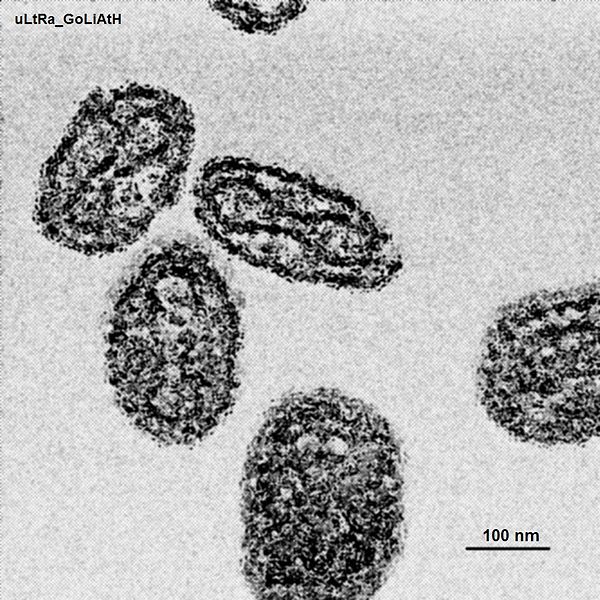Variola virus: Difference between revisions
imported>Nikil Abraham |
imported>Nikil Abraham |
||
| Line 18: | Line 18: | ||
==Genome structure== | ==Genome structure== | ||
Variola virus is a large brick shaped virus with a measurement of 302 to 350 nm by 244 to 277 nm, which consist of single linear double stranded DNA. It genome consist of 186 kbp and contain a hairpin loop at each end. | Variola virus is a large brick shaped virus with a measurement of 302 to 350 nm by 244 to 277 nm, which consist of single linear double stranded DNA. It genome consist of 186 kbp and contain a hairpin loop at each end. The hairpin loop at each end consists of 530 bp fragments. The entire genome consists of 186,102 base pairs. They have 187 closely spaced open reading frames specifying putative major proteins contain more that or equal to 65 amino acids. | ||
==Cell structure and metabolism== | ==Cell structure and metabolism== | ||
Revision as of 22:53, 15 April 2008
Articles that lack this notice, including many Eduzendium ones, welcome your collaboration! |
| Variola Virus | ||||||||||
|---|---|---|---|---|---|---|---|---|---|---|
| Virus classification | ||||||||||
|
Description and significance
Variola virus is the cause of an acute infectious disease called small pox and this believed to have emerged in human population around 10000 BC. The organism got its name from the Latin word varius meaning spotted, or varus meaning “pimple”. During 20th century alone it is estimated that 200 to 300 million people died due to small pox. After successful vaccination campaign throughout 19th and 20th century around the globe caused the virus to be eradicated from the nature completely by 1979. To present day small pox is the only human disease that has been completely eradicated from the nature There are two kinds of variola, which are V. major, and V. minor and both causes small pox while V. major has a greater mortality rate. Only host variola virus has is humans and this is one of the main reason why it was able to be eradicated from the earth.
Genome structure
Variola virus is a large brick shaped virus with a measurement of 302 to 350 nm by 244 to 277 nm, which consist of single linear double stranded DNA. It genome consist of 186 kbp and contain a hairpin loop at each end. The hairpin loop at each end consists of 530 bp fragments. The entire genome consists of 186,102 base pairs. They have 187 closely spaced open reading frames specifying putative major proteins contain more that or equal to 65 amino acids.
Cell structure and metabolism
Describe any interesting features and/or cell structures; how it gains energy; what important molecules it produces.
Variola viruses are DNA viruses, which are unique because they replicate in cytoplasm instead of nucleus like other DNA viruses. They produce variety of specialized protein for replications, which are not produced by other DNA viruses. The most important of this protein are DNA-dependent RNA polymerase. There are two kinds of these viruses, which are enveloped and non-enveloped. The viral envelope also contain a specifies protein called hemagglutinin.
Ecology
Describe any interactions with other organisms (included eukaryotes), contributions to the environment, effect on environment, etc.
Variola viruses attacks primarily human host but there are also other close relatives like vaccinia, cowpox, and monkey pox which could infect both humans and other animals.
Pathology
How does this organism cause disease? Human, animal, plant hosts? Virulence factors, as well as patient symptoms.
This organism is transmitted among humans primarily by inhalation of virus or by droplets from oral, nasal or pharyngeal mucus of an infected person. The virus usually enter in the human body through respiratory tract, grows on the mucous membrane and then spreads to the lymph nodes where it multiplies and then finally enters the blood stream. After entering the blood stream the virus invades internal organs and skin. The time frame for the incubation of small pox is 1 to 12 days. The symptoms of smallpox include high fever, bad headaches, tiredness and rashes. The death usually happens as a result of hemorrhage and toxemia.
Current Research
In 1980, WHO declared naturally occurring small pox disease to be completely eradicated from the face of the world and this caused most of the research on variola virus to come to an abrupt end. Currently variola virus is officially retained at two locations in the world one being at CDC, Atlanta and other one being at the State Research Center of Virology and Biotechnology in Novosibirsk, Russia. Due to these reasons there are not that much research currently going on Variola virus and most of the research going on is to find a better vaccination in case of a bioterrorism attack. Currently a project is going on at CDC to sequence the genome of two isolates of variola called Congo 70 and Somalia 77, which are pathogens with bioterrorism potential.
